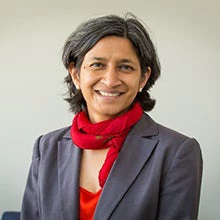 Photo: Women's economic empowerment starts with education. Students benefited from a World Bank-supported education project in rural Argentina. Copyright: Nahuel Berger/World Bank.
Photo: Women's economic empowerment starts with education. Students benefited from a World Bank-supported education project in rural Argentina. Copyright: Nahuel Berger/World Bank.
The facts around gender-based violence should stop us all in our tracks: Every 10 minutes a girl or woman is killed by a partner or close relative, and one in three women is estimated to experience gender-based violence in her lifetime.
Gender-based violence (GBV) is a pernicious and pervasive scourge that affects millions of women and girls worldwide, undermining their potential and causing damage that goes far beyond each survivor’s life. The cost in terms of lost education, lost opportunities, lost productivity, and wasted potential is huge. The impact of this trauma can run through multiple generations.
So, what to do? At the World Bank Group, we have ramped up our efforts to address and prevent GBV 10-fold in since 2012. We can and will do more. This is why we have made ending GBV and building human capital the first pillar of our new Gender Strategy.
GBV is a multi-faceted problem that’s deeply entrenched in existing inequalities. Here are several areas where we have seen progress and will continue building upon.
Shining the light on legal protections and supporting initiatives to improve women’s safety
Data from Women, Business and the Law (WBL) underscores the transformative impact of legal and economic empowerment on reducing GBV and fostering inclusive societies. The WBL index, which measures how laws and regulations in countries promote or hinder women’s economic participation, highlights the strong positive correlation between comprehensive legal protections and reduced violence. Better legal and justice systems, and comprehensive laws, can better protect women from harassment and violence by contributing to safer schools, transport systems, workplaces, and public spaces. This in turn can significantly improve a woman’s ability to fully participate in social and economic life.
To work, however, these legal frameworks need implementation. For example the Quito metro line project in Ecuador incorporated new reporting mechanisms to prevent sexual harassment and violence throughout the transport system and implemented protocols for community members to intervene in cases of sexual violence. In Dar es Salaam, Tanzania, a women-led “safety audit” process within an urban development project is helping to design new urban areas with women’s safety in mind.
Empowering women—starting with education
Economic empowerment shifts the balance of power—in households, workplaces, and communities—disrupting traditional gender roles and diminishing the control that enables abuse. On a personal level, women who have access to financial resources have greater agency, greater scope to deal with abuse, and can challenge the norms that condone violence as a means of control. Empowering women economically does not eliminate abuse or absolve perpetrators, but it can help shift societal expectations. And this starts with education.
For example, the Adolescent Girls Initiative for Learning and Empowerment in Nigeria has improved girls' education by increasing enrollment by over 700,000 while addressing early child marriage and empowering girls with the skills to resist violence. The Sahel Women's Empowerment and Demographic Dividend (SWEDD) initiative in West Africa supports 3,400 safe spaces for out-of-school girls, providing life skills and violence prevention training. It also engages men to reduce harmful gender norms and break the cycle of violence.
Connecting more women to employment and markets
Helping more women climb the ladder of opportunity from education towards full economic empowerment requires increasing access to financial resources, digital services, including IDs, training and—ultimately—jobs. This is why the World Bank Group recently set specific goals to reach up to a quarter of a billion women with social protection programs (including money, training, and market access), to connect 300 million more women to broadband services, and to enable 80 million women to access capital for their businesses. Reducing care responsibilities, whether childcare or elder care, that disproportionately fall on women, also needs to be part of the solution.
For example, in Turkey, where limited access to finance hinders job creation—particularly after the 2023 earthquake—an employment project is linking access to credit for enterprises to job-specific training opportunities, purposefully targeting women and displaced people. The International Finance Corporation has launched Empower Finance, a program to help financial institutions address the financial abuse that particularly affects women and the elderly.
And that’s not all—working with survivors
Economic empowerment, legal reforms, and improved safety are vital steps, but they must be reinforced by supporting survivors with comprehensive services. For example, in Peru nationwide "Alegra" centers provide low-income survivors of domestic violence with access to free legal services and psychological support. These centers handled more than one million consultations nationwide during 2017-2022.
Tackling GBV in the context of fragile and conflict-affected settings, where it can rage unimpeded, is especially important. The GBV Prevention and Response project in the Democratic Republic of Congo has reached over 8 million people, including holistic care for 79,000 survivors to get back on their feet, and a project in Cox’s Bazar, Bangladesh, is providing GBV and health services to thousands of forcibly displaced women.
All hands on deck
The scale of the challenge requires all partners to join efforts. We are committed to working alongside local women’s organizations, with international agencies through the Spotlight Initiative, in which we pledged together with the United Nations and European Union to address GBV, and with other multilateral development banks to collectively continue to expand our programs to prevent GBV.
The efforts to address and prevent GBV are deeply interconnected: progress in one area strengthens progress in others, creating a virtuous cycle of empowerment and protection. By adopting this holistic approach, together with our partners, we can make meaningful strides toward a world free from GBV. Let’s do it.


Join the Conversation